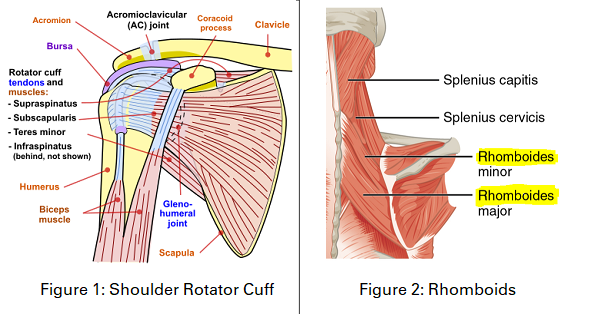The shoulder joint is the major joint connecting the upper limb to the trunk. It is also the most mobile of joints in the human body, however, because of this it is also one of the joints most susceptible to problems.
Formed by three bones: the humerus (upper arm bone), scapula (shoulder blade), and clavicle (collar bone). The shoulder joint is held together by a combinations of ligaments, muscle, and fibrous cartilage. It’s important to exercise this joint in order to build a more stable, stronger, mobile, and functional shoulder joint. It is necessary to keep this joint and all the attachments and muscles strong around it as it is the joint that operates and assists in all the motions of the arm.

Please note: If this exercises causes excessive pain or discomfort, cease exercise and seek consultation with your health professional.
Our focus this month is a structure that plays a major role in the function of the shoulder. This structure is called the ‘Scapula’ or commonly ‘The Shoulder Blade’. The Scapula services a vital role in attaching the upper arm to the trunk of the body (via the rotator cuff as shown on Fig.1). It is the foundation of the shoulder joint and holds it in place on the body.
Our exercise this month is called Shoulder Blade Squeeze, which focuses on drawing and squeezing the shoulder blades together. This exercise works particularly the central muscles of the back called the Rhomboids (Fig.2). Their role in the body is not only to draw those scapula together, but also to keep them attached to the rib cage.
This exercise is beneficial for shoulder and upper limb stability for major movements performed everyday such as pushing, pulling and holding items. It is also specifically prescribed to improve posture and avoid ‘rounded’ shoulders.
How does this exercise relate to arthritis?
Having rounded shoulders can cause strain and built up tension, particularly across the shoulders and upper neck. Overtime this excessive strain and tension can amplify wear on the joints and contribute to rotator cuff imbalances and potential dysfunction, so this exercise specifically strengthens the muscles that keep our shoulders in proper alignment. Thus reducing the strain, reducing the potential for rotator cuff issues (muscle strains, bursitis, shoulder impingement etc.) and in time assisting in reducing the odds arthritis in the shoulder.
If you are unable to follow the full range of motion shown in the exercises that is okay. Only work within your physical capabilities.
EXERCISE VIDEO
This demonstration contains general information and advice. Every effort has been made to ensure that the information is accurate and reliable. The content of this demonstration is not a substitute for individual treatment advice from your doctor or health professional. Always consult your doctor or healthcare provider to obtain individual medical, management, or treatment advice.


